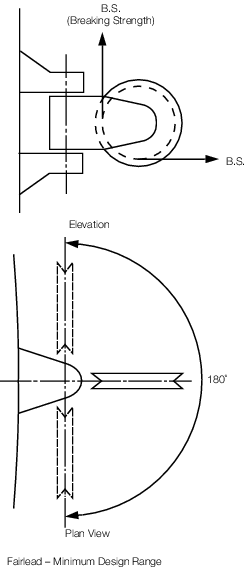4.2.2 Fairleads
and their supporting structures are to be designed for a load equivalent
to the rated minimum break strength of the anchor line.
4.2.3 Maximum allowable stresses for the design criteria given in Pt 7, Ch 8, 4.2 Fairleads 4.2.1 and Pt 7, Ch 8, 4.2 Fairleads 4.2.2 are to be based on the following factors of
safety:
| Shear
|
1,89
|
Factors relate to tensile yield stress
|
Tension, compression
or
bending
|
1,25
|
Factors relate to tensile yield stress
|
| Combined
|
1,11
|
Factors relate to tensile yield stress
|
(combined stress =  ) )
|
Where σX and σY are the combined axial and bending stresses in the X and Y
directions respectively and τ is the combined shear stress due
to torsion and/or bending in the X-Y plane.
4.2.4 Materials
and steel grades are generally to comply with the requirements given
in Pt 7, Ch 8, 5.2 Materials for Type P components.
4.2.5 Chain
cable fairleads are to have a minimum of five pockets.
4.2.6 Wire
rope fairleads are generally to have a minimum diameter of 20 times
the wire rope diameter.

Figure 8.4.1 Minimum operating range and design loading of fairlead